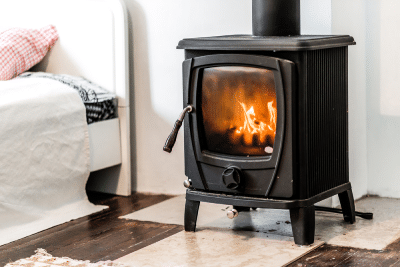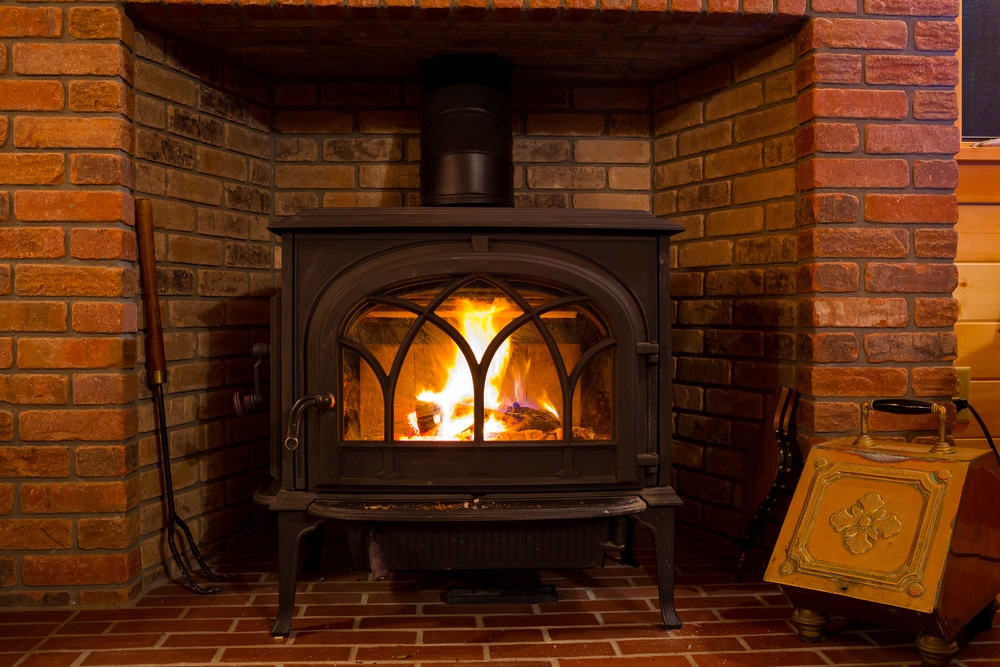There is nothing better than snuggling down on the sofa in front of a wood-burning stove. Having invested in one, you will want to get the best from it by distributing the heat output around your room.
And that’s where a stove fan comes in! This fantastic innovation is not only an environmentally friendly way to move hot air around your room, but it can also be aesthetically pleasing. Pushing the heat from the stove will also mean that you use less fuel!
So if you have been wondering where to place a stove fan to get the most from the warm air your wood stove produces, we have provided some information and tips below to help you find the best position for your fan.
What are Wood Stove Fans
Wood stove fans are heat powered and have fan blades that are activated by the rising heat from the log burner. There are many different fan models, but mostly they are made from metal, such as steel. The blades may be metal, or they may be made from silicone. Silicone blades make the fan safer if someone accidentally touches them while moving.
How Do Stove Fans Work?
Most wood stove fans are specifically designed to work without batteries or the need for a power source, simply using the hot air produced to turn the blades.
There are two main types of stove fans. The ones that create their own electricity are called thermoelectric fans. The other kind that uses the temperature difference between the air at the bottom and the top of the fan to power pistons, causing the fan blades to rotate, are known as Stirling engine fans.
Stirling Engine Stove Fans
A wood-burning stove fan is placed on the flat surface of the stove top, drawing up the heat from its base. Inside the base is a cylinder that, as the air inside it warms and expands, pushes a piston upwards. A top cool plate produces cooler air, making it contract, forcing a second piston downwards. The two pistons moving up and down drive the fan blades around.
They don’t contain electrical components or need batteries to run. The heat differential is the only thing creating the energy required to rotate the blades.
These types of fans work at a temperature of between 90 and 450°C.
Thermoelectric Stove Fans
This type of fan works by drawing up heat from the fan’s base to the blades at the top. The fan contains two semi-conductors. When the heat passes through them, they create an electrical current that powers the motor to turn the blades. As the air cools, more warm air is drawn upwards.
These stove fans can work between temperatures of 50 to 350°C.
Considerations

It is worth checking the capacity of the stove fan you are interested in purchasing. This is usually presented as the number of cubic feet the warm air will be circulated around. You need to make sure that the one you select has the capacity for your room size.
Most stove fans also work at different maximum temperatures, so make sure that you check that with the different types of wood-burning stoves on the market or the one you already have installed in your home.
The Golden Rule: Keep Your Fan at the Back
The best place to position a stove fan is at the back of the stove. This is where the fan will most efficiently capture the heat produced from the wood-burning stove and push it forward and make your room feel warmer.
If you place a stove fan too far to the front, a lot of the heat generated from the back will not be blown forward. And, you will lose out on the benefit of all that warm air.
You should also not place the stove fan in front of the stove pipe as this is the hottest section of the wood stove. But some stove flues are at the back, so you won’t have any choice but to place the fan in front of it. If it is in the middle or at the front of your wood-burning stove, place the fan behind it to make the most of the heat.
The Need for Cool Air
Although to make the most of the warm air being emitted from the stove, it is best to place the fan towards the back. The fan also needs sufficient space to draw cooler air in.
If your wood-burning stove is quite close to a wall behind it, you may need to place the fan further forward on the top surface to access more air. You will only achieve a pretty inefficient system without colder air around your stove fan.
Fan Safety
It is important to position a stove fan on your wood stove’s flat and stable area to keep it steady. Luckily, most stoves are designed with a flat top, so this should not be a problem. Positioning it near the rear of the burner will also help prevent anyone from accidentally knocking it over.
If you have children and already have a multi-fuel stove in a room, the chances are that you have all of the safety precautions you need in place. But, fans can be quite enticing to small children. It may be safer to purchase a stove fan that has blades made from silicone, rather than metal, just in case small fingers are tempted near it.
@natepetroski Reply to @bbarnesy1 #woodstove #woodfire #firewood #fan #heatpoweredstovefan
♬ original sound – Nate Petroski
Top Temperatures
The two types of stove fans operate at different temperature ranges and have maximum temperatures that they will work at. A stove thermometer is a fantastic investment to ensure that your stove does not exceed that level. This device will allow you to check that no damage will come to your stove fan and keep it working at its optimum level.
Set Up Your Stove Fan and Enjoy the Extra Warmth
A stove fan can dramatically improve the temperature in your whole room so that you can sit back and enjoy the heat emitted by your wood stove. These appliances are simple in design and relatively inexpensive to purchase. Plus, they work on various stove types, from pellet stoves, gas stoves, and wood-burning stoves.
A heat-powered stove fan entails no added running costs. All you need is to place it in the correct position to make the most of the hot, cosy air coming into your room.
So if you have asked yourself where to place a stove fan, we hope we have provided you with all the information you need to get the most from wood-burning stoves in your home!
Additional Resources
- How to Install an Under Sink Water Filter System
- How Does An Under Sink Water Filter Work
- How to Use a Mini Oven
- What Temperature Should a Freezer Be
Tom is a former chef turned full-time food blogger. He has always been passionate about food, and loves nothing more than experimenting in the kitchen and sharing his recipes with others. Tom’s blog is one of the most popular food blogs on the internet, and he has won numerous awards for his cooking. When he’s not blogging or cooking, Tom enjoys spending time with his wife and two young children.

